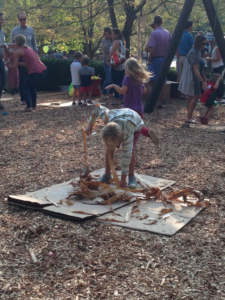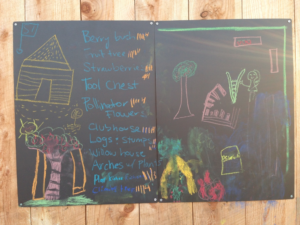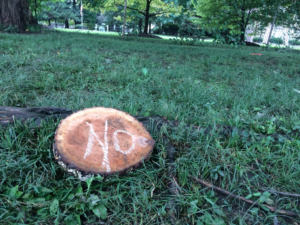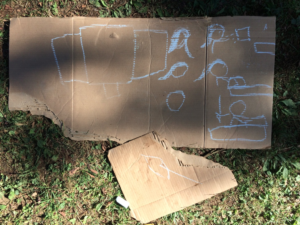A Reflection by Rachel Brunner, CAPN Free Play Facilitator
 On the days I am not cutting out cardboard box doors and windows or deconstructing a teepee village before another group of kids arrives to play, I work as a community organizer at gardens, farms and orchards in the city. My main role in this position is to listen, build trust with people in the community, and create space for members to brainstorm ideas, develop a common vision, identify skills and resources available to them, and begin turning their ideas into reality. The gardeners and farmers I have the privilege of working with live in underserved communities, and many of the history books in these areas would show a pattern of people with good intentions telling the residents what they need to make their lives better, making promises to invest time or money in their neighborhood, and then leaving before the promise is seen through or when their efforts are unsuccessful. After generations of this cycle of a lack of resources, other people speaking for communities that aren’t their own, and creating a culture of reliance, it is understandable that people may become disheartened and unmotivated to make positive change in their neighborhoods.
On the days I am not cutting out cardboard box doors and windows or deconstructing a teepee village before another group of kids arrives to play, I work as a community organizer at gardens, farms and orchards in the city. My main role in this position is to listen, build trust with people in the community, and create space for members to brainstorm ideas, develop a common vision, identify skills and resources available to them, and begin turning their ideas into reality. The gardeners and farmers I have the privilege of working with live in underserved communities, and many of the history books in these areas would show a pattern of people with good intentions telling the residents what they need to make their lives better, making promises to invest time or money in their neighborhood, and then leaving before the promise is seen through or when their efforts are unsuccessful. After generations of this cycle of a lack of resources, other people speaking for communities that aren’t their own, and creating a culture of reliance, it is understandable that people may become disheartened and unmotivated to make positive change in their neighborhoods.
While my work begins with the creation of space for conversations to start, little would come of this space if I didn’t quickly hand it over to the community and use my new privilege of knowing people in the group to protect their space from anything that may try to interrupt community decision making.
During my time as a play facilitator, it has been eye opening to realize that the kids at each play day make up one of these communities- or, more accurately, the entire population of humans under the age of 18 is one of these communities. This community, our most vulnerable and malleable community, is in need of a protected

space. A space to speak about why they are sad, glad, or angry. A space to imagine something different that will bring joy to themselves and their friends. A space to try something they’ve never done before and fail. A space to learn and try again without judgement. A space where everyone is trusted to test and learn their personal limits when it comes to interacting with another person, or plunger, or makeshift bridge, or straw castle.
As I stand guard to protect the play space we’ve created during a Children at Play Network free play day, I have a new opportunity to see a community through the eyes of a child. I form strategies with other facilitators to listen to (or eavesdrop on) the players as they tell new friends about their fort plans or paint a picture of the imaginary world they’re jumping into. As outsiders, adults, and parents, we have the natural instinct to want to be involved, to have memorable experiences with children when we’re off work, and to guide them to make “good” and “safe” decisions in an unknown place. There is a place for these lessons and experiences when we’re interacting in a family or alternative community, but during free play, we adults aren’t members of the kid community.
Just as in community organizing, if an outsider comes in and tells residents that a lack of job opportunities is the main challenge in their neighborhood, while most people are concerned about the quality and safety of schools, then most of the efforts the outsider makes to improve job access will not be sustainable. The same goes when we notice a kid is starting to tie a messy knot around a few sticks that looks like the beginnings of a teepee, and we have the instinct to jump in and “help,” showing them how to tie a “real” knot and taking the liberties of setting up the sticks in the shape of a teepee. More often than not, the player won’t tell you “no.” They will let you help since they’ve been trained to respect you as a leader in other communities, but may not tell you that they were actually tying the knot so they could lean it against a cardboard box as a ramp and then realize they didn’t want the knot because they found a roll of tape beside them that may work better. And then as they used the tape they realized they didn’t care about the ramp after all and instead wanted to use this abundant resource of tape to run back and forth across the field for fun.
 By making the decision that the child needed help with the knot and the assumption that they wanted to build a teepee, we took their option to involve an adult, their power of decision making, and their opportunity for creative problem solving away from that moment. The threat of doing this over and over again could easily result in the same disheartened reliance and lack of empowerment that is felt by many communities in the city.
By making the decision that the child needed help with the knot and the assumption that they wanted to build a teepee, we took their option to involve an adult, their power of decision making, and their opportunity for creative problem solving away from that moment. The threat of doing this over and over again could easily result in the same disheartened reliance and lack of empowerment that is felt by many communities in the city.
While standing at my post on the edge of the play area, I think through my list of community organizing techniques in the play community- many of which are the same everywhere, and some that I tailor to fit the community’s unique needs:
- Listen
- Wait to be asked
- Encourage them to do it on their own
- Wait to be asked again
- Gauge if you should encourage them to do it again, or demonstrate the skill on something else so they have the opportunity to do it for themselves
- Step away (far away) after you’ve helped with the single thing you’ve been asked to do
- Provide access to resources when asked (ex. When asked if you have any tape, point in a general direction that you may have seen tape over there so they can search for themselves and maybe decide to come back with rope instead) or drop materials around the space without interrupting the play flow of the players
- If something looks legitimately dangerous, walk by and ask “do you feel safe?” to keep the responsibility of risk on the player
Kids are part of a community that has the socially acceptable excuse to play instead of work and it is amazing to get to empower them from a young age to know they can make decisions, solve problems, make mistakes, make new friends, get hurt, get back up, and be able to do it all over again. This is a community that far too often is forced to behave older than they are and at the same time aren’t allowed to make empowering decisions for themselves and then struggle when they join the community of over 18-year-olds. We have the privilege to witness this community at work and protect it by changing the conversations and stepping back to allow space for kids to grow. I’m honored to be on a team of facilitators who are committed to protecting this community and to have other adults to speak openly with about mistakes, play stories, and radical ideas to make sure kids can be kids. Communities across our city will never function as islands separate from the rest, but we have the choice to function together and support each other through trust and empowerment.
The plans of many play communities are just as valid and remarkable as the plans developed in adult communities.
